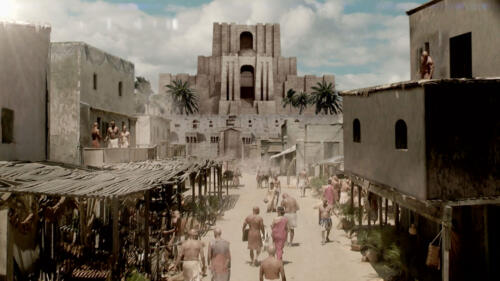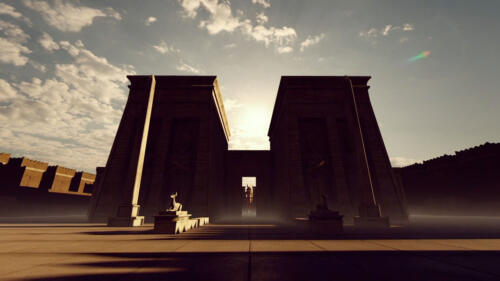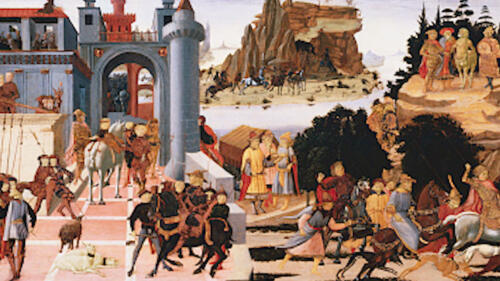Ancient Middle East
The ancient Middle East—often referred to as the “cradle of civilization”—gave rise to some of the greatest empires in human history, including Mesopotamia, Babylonia, the Persian Empire and the Byzantine Empire.
Featured Overview
Get an overview of the ancient leaders who oversaw the expansion and growth of civilizations around the world.
3:23m watch

Illustration by Eduardo Ramón Trejo. Photos from Getty Images.
Featured Overview
Get an overview of the ancient leaders who oversaw the expansion and growth of civilizations around the world.
3:23m watch
Start Here

A largely tolerant and merciful ruler, Persian king Cyrus the Great established one of the largest empires in world history.

The Sumerian people of Mesopotamia had a flair for innovation. Here's how they left their mark.

Environmental factors helped agriculture, architecture and eventually a social order emerge for the first time in ancient Mesopotamia.

The collection of laws and regulations carved into stone thousands of years ago carries principles and ideas that are still applied today.
8 Ancient Empires
8 Ancient Empires You’ve Never Heard Of
Grab your fedora and bullwhip as we unearth 8 amazing yet obscure ancient empires, in this episode of History Countdown.
9:42 watch

3 Goods Traded Along the Silk Road
Explore All Related Topics

They include art looted by Nazis and antiquities snuck out of dig sites and auctioned. Museums are starting to repatriate the treasures.

Hidden for thousands of years beneath a Turkish hillside, this ancient site may be the key to understanding early religion.

These seven artifacts show us that even ancient civilizations couldn’t escape taxes.

Archaeologists decoded part of the ‘unknown’ writing system from the Kushan Empire using the same technique that helped decipher the Rosetta Stone.

A priestess named Enheduanna claimed authorship to poetry and other texts—sometimes in first-person—more than a millennium before Homer.

The collection of laws and regulations carved into stone thousands of years ago carries principles and ideas that are still applied today.

Hammurabi's Code may get all the attention, but barley and wool were the mainstays of Babylonian day-to-day life and commerce.

A largely tolerant and merciful ruler, Persian king Cyrus the Great established one of the largest empires in world history.

The vibrant network opened up exchanges between far-flung cultures throughout central Eurasia.
Discover the true story of ancient, but lesser known, civilizations like Nineveh, Catalhoyuk, and Tiwanaku, in this episode of History Countdown.
10:35m watch
Discover these 10 incredible structures that were constructed by ancient civilizations but remain shrouded in mystery, in this episode of History Countdown.
11:25m watch
Grab your fedora and bullwhip as we unearth 8 amazing yet obscure ancient empires, in this episode of History Countdown.
9:42m watch

Environmental factors helped agriculture, architecture and eventually a social order emerge for the first time in ancient Mesopotamia.

The ancient Babylonian king ruled with military and diplomatic finesse—and he also knew a thing or two about self-promotion.

The Silk Road was a vital trading route connecting East and West—but it also became a conduit for one of history's deadliest pandemics.

The Sumerian people of Mesopotamia had a flair for innovation. Here's how they left their mark.

These tantalizing archaeological finds may—or may not—offer material evidence of ancient locations, characters and stories written about in the Bible.

Babylon, largest city of the Babylonian Empire and located in modern-day Iraq, was famed for the Hanging Gardens of Babylon, Ishtar Gate and Tower of Babel.

The Persian Empire is the name given to a series of dynasties centered in modern-day Iran, beginning with the conquests of Cyrus the Great around 550 B.C.

Petra is an archeological site in present-day Jordan. Known for its rock-cut architecture, the city was established as a trading post in the 4th century B.C.

Palmyra is an ancient archaeological site located in modern-day Syria. Originally founded near a fertile natural oasis, it was established sometime during the third millennium B.C. as the settlement of Tadmor, and it became a leading city of the Near East and a major trading post on the Silk Road.

Masada is an ancient stone fortress located high above the Dead Sea, its well-preserved ruins attesting to the history of the ancient kingdom of Israel.

Sumer was an ancient civilization founded in the Mesopotamia region of the Fertile Crescent, its people known for innovations in language, governance and more.

Mesopotamia was a region of southwest Asia between the Tigris and Euphrates rivers from which human civilization and world-changing inventions emerged.

The Silk Road was a network of trade routes connecting China and the Far East with the Middle East and Europe. Established when the Han Dynasty in China officially opened trade with the West in 130 B.C., the Silk Road routes remained in use until A.D. 1453, when the Ottoman Empire boycotted trade with China and closed them.

Jerusalem is a city located in modern-day Israel and is considered by many to be one of the holiest places in the world. Jerusalem is a site of major significance for the three largest monotheistic religions: Judaism, Islam and Christianity. Both Israel and Palestine have claimed Jerusalem as a capital city.

Scientists have confirmed that the Black Death and another huge plague epidemic in the sixth century were caused by different strains of the same bacterium.

Explore 10 fascinating facts about the medieval empire that bridged the gap between the classical world and the Renaissance.

It likely originated in ancient Mesopotamia.

Check out nine fascinating facts about one of the earliest sophisticated civilizations known to history.

Find out more about the fascinating history behind one of antiquity’s most important legal codes.
The invention of written language replaced the oral tradition and allowed civilizations to store and share knowledge.
2:22m watch
Byzantine Emperor Justinian's plans to reunite the Roman Empire are thwarted by an unlikely foe.
3:32m watch

The Byzantine Empire was a powerful nation, led by Justinian and other rulers, that carried the torch of civilization until the fall of its capital city Constantinople.

The Code of Hammurabi was one of the earliest and most complete written legal codes. It was proclaimed by the Babylonian king Hammurabi.

Attila the Hun was the leader of the Hunnic Empire from 434 to 453. Also called Flagellum Dei, or the “scourge of God,” Attila was known to Romans for his brutality and a penchant for sacking and pillaging Roman cities.








